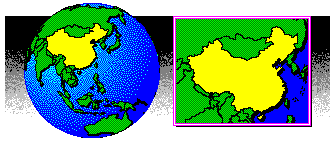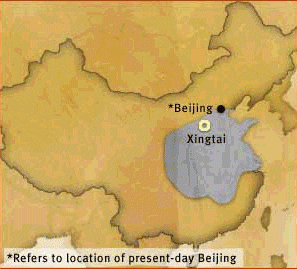Updated with significant terms
on Thurs 9/8/99, 4AM
Chinese Geography and
Ethnography:
Who's China?
Significant terms:
* Tokarian
* Han Chinese
* Pinyin
Review Questions in Red:
 Before we dive into
Chinese history, we have to be careful of what we call Chinese. Like our own
impressions of China and the Western historiography of China, we should be must
be careful not to make generalizations. The China today is not the China of four
thousand years ago. The PBS video on the Tokarian mummies of Northwestern China
with distinctly European characteristics illustrates well the controversy
surrounding what constitutes ethnic Chinese historically. Why
did the Chinese officials keep the mummies a secret for most of the twentieth
century? The answer to that question should at least lead
us to conclude that the ethnography of the land area that we now consider China
proper is extremely varied from East to West and North to South. After all, the
geography is extremely varied, from dry deserts and grasslands in the north to
sub-tropical rice-growing regions in the South. Five semi-autonomous regions and
300 different languages in modern China paint a more complex picture of China
than the stereotypical picture of an ethnically homogenous culture. There is a
core culture, however, the geographic area of which expanded and contracted with
the rise and fall of its numerous dynasties. This is the China that we will
focus on primarily in class.
Before we dive into
Chinese history, we have to be careful of what we call Chinese. Like our own
impressions of China and the Western historiography of China, we should be must
be careful not to make generalizations. The China today is not the China of four
thousand years ago. The PBS video on the Tokarian mummies of Northwestern China
with distinctly European characteristics illustrates well the controversy
surrounding what constitutes ethnic Chinese historically. Why
did the Chinese officials keep the mummies a secret for most of the twentieth
century? The answer to that question should at least lead
us to conclude that the ethnography of the land area that we now consider China
proper is extremely varied from East to West and North to South. After all, the
geography is extremely varied, from dry deserts and grasslands in the north to
sub-tropical rice-growing regions in the South. Five semi-autonomous regions and
300 different languages in modern China paint a more complex picture of China
than the stereotypical picture of an ethnically homogenous culture. There is a
core culture, however, the geographic area of which expanded and contracted with
the rise and fall of its numerous dynasties. This is the China that we will
focus on primarily in class.  This is the China's who's language we have written
evidence of since the Shang dynasty around 1700 BCE. There is certainly much
cross-cultural contact between the core Chinese culture and surrounding
cultures. We will explore these relationships through our group studies of the
five semi-autonomous regions and a broad view of the Eurasian trade networks
historically. What was the relationship between the
Chinese and the various cultures over the history of the core Han Chinese
culture? There will be many answers to this question throughout our
course of study.
This is the China's who's language we have written
evidence of since the Shang dynasty around 1700 BCE. There is certainly much
cross-cultural contact between the core Chinese culture and surrounding
cultures. We will explore these relationships through our group studies of the
five semi-autonomous regions and a broad view of the Eurasian trade networks
historically. What was the relationship between the
Chinese and the various cultures over the history of the core Han Chinese
culture? There will be many answers to this question throughout our
course of study.
Maps:
-
Physical
Geography
-
Agricultural
-
Linguistic
-
Modern
Population Density
-
Han
Empire
Back to the
Syllabus/E-Zine Index
 Before we dive into
Chinese history, we have to be careful of what we call Chinese. Like our own
impressions of China and the Western historiography of China, we should be must
be careful not to make generalizations. The China today is not the China of four
thousand years ago. The PBS video on the Tokarian mummies of Northwestern China
with distinctly European characteristics illustrates well the controversy
surrounding what constitutes ethnic Chinese historically. Why
did the Chinese officials keep the mummies a secret for most of the twentieth
century? The answer to that question should at least lead
us to conclude that the ethnography of the land area that we now consider China
proper is extremely varied from East to West and North to South. After all, the
geography is extremely varied, from dry deserts and grasslands in the north to
sub-tropical rice-growing regions in the South. Five semi-autonomous regions and
300 different languages in modern China paint a more complex picture of China
than the stereotypical picture of an ethnically homogenous culture. There is a
core culture, however, the geographic area of which expanded and contracted with
the rise and fall of its numerous dynasties. This is the China that we will
focus on primarily in class.
Before we dive into
Chinese history, we have to be careful of what we call Chinese. Like our own
impressions of China and the Western historiography of China, we should be must
be careful not to make generalizations. The China today is not the China of four
thousand years ago. The PBS video on the Tokarian mummies of Northwestern China
with distinctly European characteristics illustrates well the controversy
surrounding what constitutes ethnic Chinese historically. Why
did the Chinese officials keep the mummies a secret for most of the twentieth
century? The answer to that question should at least lead
us to conclude that the ethnography of the land area that we now consider China
proper is extremely varied from East to West and North to South. After all, the
geography is extremely varied, from dry deserts and grasslands in the north to
sub-tropical rice-growing regions in the South. Five semi-autonomous regions and
300 different languages in modern China paint a more complex picture of China
than the stereotypical picture of an ethnically homogenous culture. There is a
core culture, however, the geographic area of which expanded and contracted with
the rise and fall of its numerous dynasties. This is the China that we will
focus on primarily in class.  This is the China's who's language we have written
evidence of since the Shang dynasty around 1700 BCE. There is certainly much
cross-cultural contact between the core Chinese culture and surrounding
cultures. We will explore these relationships through our group studies of the
five semi-autonomous regions and a broad view of the Eurasian trade networks
historically. What was the relationship between the
Chinese and the various cultures over the history of the core Han Chinese
culture? There will be many answers to this question throughout our
course of study.
This is the China's who's language we have written
evidence of since the Shang dynasty around 1700 BCE. There is certainly much
cross-cultural contact between the core Chinese culture and surrounding
cultures. We will explore these relationships through our group studies of the
five semi-autonomous regions and a broad view of the Eurasian trade networks
historically. What was the relationship between the
Chinese and the various cultures over the history of the core Han Chinese
culture? There will be many answers to this question throughout our
course of study.